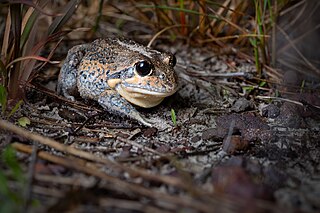
Limnodynastes dumerilii is a frog species from the family Limnodynastidae. The informal names for the species and its subspecies include eastern or southern banjo frog, and bull frog. The frog is also called the pobblebonk after its distinctive "bonk" call, which is likened to a banjo string being plucked. There are five subspecies of L. dumerilii, each with different skin coloration. The species is native to eastern Australia. There has been one occurrence in New Zealand, when tadpoles of the species were found in 1999 and destroyed.

The giant burrowing frog or eastern owl frog is a large frog species that occurs in coastal south-east New South Wales and Victoria in Australia. It is also known as the owl frog, southern owl frog, spotted owl frog, burrowing owl frog.
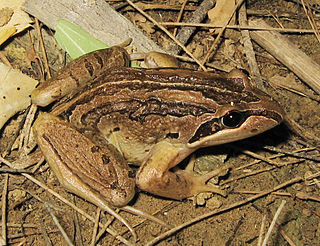
The striped marsh frog or brown-striped frog is a predominantly aquatic frog native to coastal Eastern Australia. It is a common species in urban habitats.

The pig frog is a species of aquatic frog found in the Southeastern United States, from South Carolina to Texas. Some sources also refer to it as the lagoon frog or the southern bullfrog.
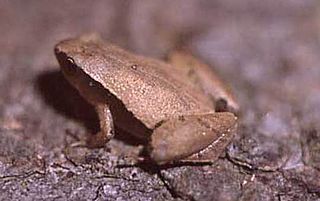
Microhyla heymonsi, also known as the dark-sided chorus frog or the Taiwan rice frog, is a species of narrow-mouthed frog found in northeastern India, southern China, Taiwan, and Southeast Asia south to the Malay Peninsula and Sumatra as well as the Great Nicobar Island. It was originally described from Taiwan.

The granular poison frog or granular poison arrow frog is a species of frog in the family Dendrobatidae, found in Costa Rica and Panama. Originally described as Dendrobates granuliferus, it was moved to Oophaga in 1994. Its natural habitats are tropical humid lowland forests; it is threatened by habitat loss.
Minyobates steyermarki is a species of frog in the family Dendrobatidae endemic to Cerro Yapacana in southern Venezuela. It is also known by the common names of demonic poison frog, demonic poison-arrow frog, or Yapacana's little red frog. It is monotypic in the genus Minyobates.

Triprion spinosus, also known as the spiny-headed tree frog, spiny-headed treefrog, spinyhead treefrog, coronated treefrog, and crowned hyla, is a species of frog in the family Hylidae. It has a spotty distribution in Panama, Costa Rica, Honduras, and southern Mexico. Previously in its own monotypic genus Anotheca Smith, 1939, it was transferred to the genus Triprion in 2018.

Annam tree frog, also known as the South China tree toad, is a species of frog in the family Hylidae. It is found in southern China, Vietnam, and Laos. The Hainan tree toad from Hainan Island is treated as a subspecies.

Kaloula rugifera, the Sichuan digging frog or Szechwan narrowmouth toad, is a species of frog in the family Microhylidae found in China.

Micryletta erythropoda, commonly known as the Mada paddy frog, is a species of frog in the family Microhylidae. It is known from Myanmar, Thailand, and Vietnam. Its natural habitats are swamps, freshwater marshes, and intermittent freshwater marshes. While formerly classified in the genus Microhyla, a 2018 study found it to belong to the genus Micryletta instead. A study performed in 2019 found that several Micryletta populations in southern Myanmar and Thailand that were formerly assigned to M. inornata actually belong to M. erythropoda; prior to this, M. erythropoda was considered endemic to Vietnam.
Uperodon nagaoi, also known as the Nagao's pug-snout frog or Nagao's globular frog, is a species of frogs in the family Microhylidae. It is endemic to Sri Lanka and is known from the Central, Sabaragamuwa, Southern, and Western Provinces. The specific name nagaoi honours Eijiro Nagao, president of Marusan Securities who, through the Nagao Environmental Foundation, has supported research on Sri Lankan amphibians.

Nannophrys ceylonensis, commonly known as the Sri Lanka rock frog or the Ceylon streamlined frog, is a species of frog. It used to be placed in the large frog family Ranidae but a phylogenetic study was undertaken using DNA sequences and it is now included in the family Dicroglossidae. It is endemic to Sri Lanka where its natural habitats are subtropical or tropical moist lowland forests, subtropical or tropical moist montane forests, rivers and streams.

Rana longicrus, also known as the Taipa frog or long-legged brown frog, is a species of frog in the family Ranidae. It is distributed to northern and central Taiwan.

The Peralta frog, or montane leopard frog, Lithobates taylori, is a species of frog in the family Ranidae found in Costa Rica and Nicaragua.

Kurixalus idiootocus is a small species of frog in the family Rhacophoridae. It is endemic to Taiwan and is commonly known as the temple tree frog. Its natural habitats are subtropical or tropical moist shrubland, seasonally wet or flooded lowland grassland, freshwater marshes, intermittent freshwater marshes and irrigated land. It is listed as being of "Least Concern" by the IUCN although there may be some destruction of its habitat.
Zhangixalus omeimontis is a species of frog in the family Rhacophoridae endemic to China. Its common name is Omei whipping frog or Omei treefrog, in reference to its type locality, Mount Emei (Chinese: 峨嵋山; pinyin: Éméi Shān; Wade–Giles: O2-mei2 Shan1) in Sichuan. It is found in southern and central China in Yunnan, Sichuan, Guangxi, Guizhou, Hunan, and Hubei provinces. It has been observed between 200 and 700 meters above sea level. It is a relatively common frog that inhabits forests, and sometimes farmland. It breeds in still water (pools and ponds). Agriculture and logging are threats to this species.
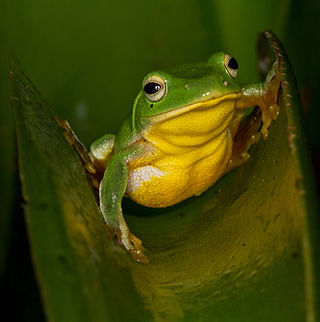
The Taipei tree frog is a species of frog in the family Rhacophoridae. It is endemic to central and northern Taiwan. It is a medium-sized tree frog; females are 4.5–5.5 cm (1.8–2.2 in) in snout-vent length, and males are slightly smaller 3.5–4.5 cm (1.4–1.8 in).
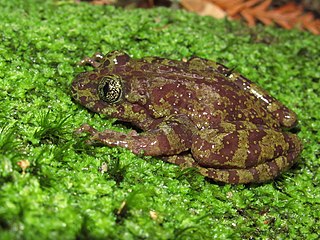
Rose's ghost frog, or Table Mountain ghost frog, is a species of frog in the family Heleophrynidae endemic to South Africa. It is a medium-sized species with purple or brown blotches on a pale green background and large discs on its fingers and toes. It has a very restricted range, being only known from the slopes of parts of Table Mountain. The tadpoles live in permanent streams but these are in danger of drying up because of the establishment of pine plantations. Because of its small range and changes in its habitat, this frog is listed as critically endangered by the International Union for Conservation of Nature.
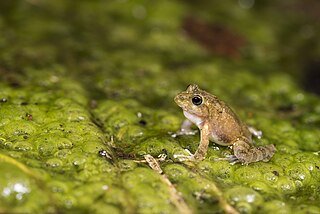
Buergeria choui is a species of frog in the family Rhacophoridae. Prior to its description in 2020, it was confused with Buergeria japonica. It is found in northwestern Taiwan and in the southern part of the Ryukyu Archipelago, Japan, specifically on the Yaeyama Islands. Common name Yaeyama Kajika frog has been proposed for it. The specific name choui honors Wen-Hao Chou from the National Museum of Natural Science (Taiwan), the first person to pay attention to the variation within the former Buergeria japonica.


















